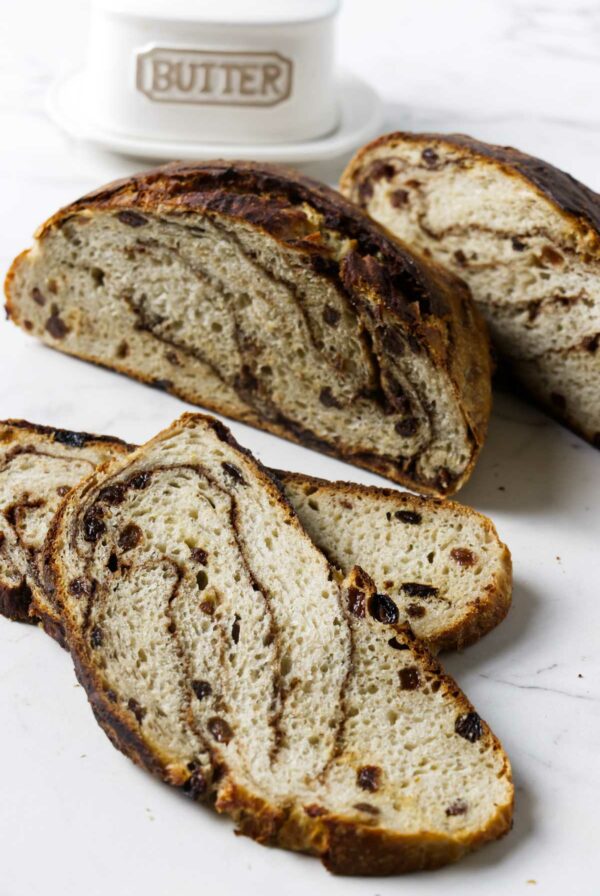This post may contain affiliate links. Please read our disclosure policy. As an Amazon Associate, I earn from qualifying purchases.
Sprouted wheat bread is the ultimate homemade comfort food, and this recipe creates an ultra-soft, tender loaf that’s perfect for sandwiches, toast, or simply enjoying on its own.
Using sprouted wheat flour gives you all the benefits of whole grains, with a light, fluffy texture and a subtle, natural sweetness brought out by the sprouting process. The flavor is mild yet rich, without the bitterness you might expect from whole wheat.

There’s nothing quite like homemade bread, especially with the nutty, earthy flavor of sprouted wheat. Store-bought bread doesn’t stand a chance. And bonus: your house will smell incredible while it bakes.
Try it with a dab of butter or a dip of garlic butter sauce or herbed olive oil.

Here is Why This Recipe Works
Ultra-soft texture: Thanks to the sprouted grain flour, this bread is unbelievably soft and tender. No dense, heavy loaves here!
Naturally sweet: The sprouting process brings out a subtle sweetness, so you won’t get that bitter whole wheat taste that some breads have.
Foolproof method: No fancy equipment or techniques required. Just a few simple steps, and you’re on your way to homemade bread heaven.
Perfect for any meal: From toast in the morning to sandwiches for lunch, this recipe will have you baking it on repeat.

The Ingredients
- Pantry: Sprouted wheat flour, instant yeast, honey, salt, olive oil
- Dairy: Butter, buttermilk
Make sure you use sprouted whole wheat flour in this recipe, and not just sprouted grains.


What’s the Difference Between Sprouted Wheat Flour and Sprouted Grains?
Sprouted grains are whole grains like wheat berries that have been allowed to germinate or sprout. They are often used whole in recipes, offering a hearty, chewy texture and slightly sweet flavor.
Sprouted wheat flour, on the other hand, is made by milling those sprouted grains into flour.
Although it looks like regular whole wheat flour, sprouted wheat flour is quite unique. It’s finely ground after the wheat has been sprouted and dried. This process gives the flour a milder taste and softer texture, perfect for making tender, ultra-fluffy bread.




Variations
Honey Oat Sprouted Whole Grain Bread: Stir in ½ cup of rolled oats and drizzle an additional tablespoon of honey into the dough. Sprinkle extra oats on top before baking.
Sunflower and Flax Bread: Mix in ¼ cup of sunflower seeds and 2 tablespoons of ground flax seeds into the dough. Top the loaf with more sunflower seeds for a rustic look.
Herb and Garlic Bread: Add 1 tablespoon of minced fresh garlic and 2 tablespoons of chopped fresh rosemary or thyme to the dough just before you shape it into loaves. Ingredients like fresh herbs and garlic can inhibit the yeast so it is best to add them toward the end of the process.

Tips for Success
Here are a few tips that I have learned along the way.
- Keep the dough wet. This dough is meant to be sticky! Resist the urge to add more flour. Wet hands and tools will help manage the stickiness.
- Use lukewarm liquids: Make sure the buttermilk mixture is no warmer than 95°F to avoid killing the yeast.
- The dough may take longer to rise depending on your kitchen’s temperature; give it the time it needs to double in size.
- Use commercially ground sprouted wheat flour. While sprouting grains at home and grinding them in a home mill works, commercially ground flour will produce a lighter, fluffier loaf and more consistent results.
- Don’t overproof. Be careful not to let the dough rise too much in the pans. Aim for 1 to 1-½ inches above the rim to avoid deflating.
- Use the stretch and fold technique. This method builds gluten while handling the dough less. Simply stretch and fold the dough a few times, wait for a bit, and repeat. After three or four rounds, the gluten will develop just as if you kneaded the dough for 15 minutes.
- Let the bread cool completely before slicing; though I can never resist pinching off a piece while it’s still warm from the oven! Hopefully, you have better self-control than I do.

Storage
On the counter: To store leftover sprouted wheat bread, let it cool completely before wrapping it tightly in plastic wrap. Store it at room temperature for up to 3 days.
Freezing: Slice the bread before freezing for easier portions. Wrap individual slices or the whole loaf tightly in plastic wrap, then place it in a freezer-safe bag or container. The bread will keep for up to 3 months in the freezer.
Note: When I slice the bread before freezing, I like to add a square of parchment paper between the slices to keep them from sticking together.

Here Are Some Other Recipes You Might Like:
- Sprouted Wheat Cranberry Bars
- Easy Sourdough Bread Recipe
- Sprouted Rye Bread
- Einkorn Sandwich Bread
- Sprouted Spelt Walnut Bread
- Cracked Wheat Bread
Pin this now to find it later!
Pin It
Sprouted Wheat Sandwich Bread
If you make this recipe, please leave a star rating and comment.
Ingredients
- 6 ⅔ cups sprouted wheat flour, 800 grams
- 2 ¼ teaspoons instant dry yeast, 7 grams
- 2 teaspoons salt, 14 grams
- 4 tablespoons butter, 56 grams
- 3 cups buttermilk, ( 735 grams)
- 5 tablespoons honey, 100 grams
Instructions
- In a large bowl, stir together the flour, yeast, and salt.
- Melt the butter in a small saucepan and then add the buttermilk and honey. Gently warm over medium heat until it is just lukewarm. If it gets too warm, let it sit and cool down to about 95°F because if the liquid is too hot, it will kill the yeast.
- Add the buttermilk mixture to the flour mixture and stir until all the flour is incorporated. The dough will be very wet and sticky. Let it rest for 5 minutes to give the flour time to fully hydrate then stir the dough for 1 minute.
- Spread some olive oil on a work surface and scrape the dough onto the oiled work surface. Using wet hands (to prevent the dough from sticking to your hands) stretch the dough up and fold it over itself four times. Then cover it with a bowl and set it aside for 5 to 10 minutes (don’t worry if you get distracted and 20 or 30 minutes go by, just be sure to give the dough at least 5 minutes to rest). Repeat this same stretch and fold process three more times. You will notice the dough firm up each time you repeat the process.
- Put the dough into a well-oiled bowl then coat the top of the dough with oil and cover the bowl with plastic wrap. Let the dough rise for 1 to 2 hours until doubled in size (the time it takes to double in size will depend on the temperature and humidity of your environment).
- While the dough is rising, grease two 4-½ by 8-inch loaf pans with vegetable oil.
- After the dough has had time to double in size, transfer it onto a greased counter. Divide the dough in half and shape each piece into a loaf and place into the loaf pans. Oil the tops of the bread loaves. Cover the loaves loosely with plastic wrap and let them rise until they have risen about 1-½ times their original size, but not quite doubled. If you are using a 4-½ by 8-inch pan the loaves should be about 1 to 1-½ inches above the top of the pan.
- While the dough is rising, preheat the oven to 350° F.
- Place the risen bread loaves in the center of the oven and bake for 20 minutes then rotate the pans and bake for another 25 to 30 minutes until the tops are a golden brown color and they sound hollow when you thump them.
- Remove the bread from the pans and place them on a wire rack to cool.
Video
Notes
- The dough will be wet and sticky. If you keep your hands and tools wet or well oiled then the dough will not stick to your hands. I keep a small bowl of water close by to dip my hands and bowl scraper into.
- After the dough is shaped into a loaf make sure you don’t over-proof the dough. If you let the dough rise too far then it will deflate very easily and leave you with a collapsed loaf of bread. The dough should rise to 1 to 1-1/2 inches above the top of the pan. It is better to ere on the smaller size than to over-proof the dough.v
- Sprouted wheat flour tends to absorb moisture differently based on your local humidity. If the dough feels excessively sticky or too dry, try adjusting slightly by adding more flour or liquid, a little at a time until it feels right.
- One tester found that using a stand mixer helped develop the dough more evenly.
- Warmer kitchens can speed up the rise time, while cooler environments may slow it down. If your kitchen is on the cooler side, try placing the dough in a slightly warm spot to help it rise. A laundry room warmed by a running dryer works well.
- Nutrition info is based on 22 slices per loaf of bread
Nutrition
Nutrition information is automatically calculated, so should only be used as an approximation.
 Like this recipe? Rate & comment below!
Like this recipe? Rate & comment below!














After making the world’s best pancake recipe (to me at least, so far) from this site – Sprouted Wheat Pancakes – I expected the Sprouted Wheat Sandwich Bread to be extra good. And it is! I cut the recipe in half to make one loaf and it was moist and soft with just the right crust. Another hit for Savor the Best.
Aw, this made my day. Thank you! I’m so glad the sprouted wheat bread lived up to the pancakes. Thanks so much for the comment.
This is one of the best bread recipes I have ever tried. Thank you for the recipe! It is delicious and a family favorite!
Thank you so much! I’m thrilled to hear your family loves the recipe—that seriously makes my day.
Great flavor. However it was difficult to slice – too soft. Would adding vital wheat gluten help? Perhaps I let it rise too long in loaf pan before baking? Please help -I want to keep making this wonderful bread. Thanks
Yes, soft bread can be tricky to slice. Here are a few tips. Turn the loaf of bread on its side and slice from one side to the other instead of from top to bottom. Since the top usually has a thicker crust, it is easier to slice through the sides. You can also partially freeze the bread. Just freeze it enough to make it a bit firmer but not too much or it will be too hard to slice. I also found a double serrated bread knife works much better than a standard serrated knife. I have a Wusthoff bread knife and haven’t tested different brands yet but I imagine less expensive brands will work just as well. CooksIllustrated did a review on more affordable standard bread knives and found the Mercer bread knife and the Fibrox Pro bread knives did very well. They aren’t double serrated knives but they are much more affordable and got good reviews.
@Dahn Boquist,
Thanks Dahn. Will try the freezing trick. Would adding vital wheat gluten help?
I’m not sure how this dough would respond to vital wheat gluten. I’m guessing it would make the crust a bit crispier but I don’t think it would make the bread firmer. Typically, it is used to give the bread more gluten so the protein bonds will be stronger which will allow the bread to rise higher without collapsing. The higher rise gives the bread a softer, lighter texture. It’s what commercial bakeries use to help whole wheat bread have a soft, springy texture.
The vital wheat gluten might also be counter-productive to your intentions for making this sprouted bread recipe. Adding a concentrated amount of gluten that comes from non-sprouted wheat may not be the healthiest option.
You might want to try reducing the hydration in the recipe. One of the reasons this bread has such a soft, springy texture is the high hydration. I’m not sure how much water you will need to reduce in the recipe but you might try adding the water gradually until you have a dough that feels like standard bread dough. One that you can knead by hand in a traditional kneading fashion instead of the stretch and fold method. However, you will not need to knead this dough very much because the gluten structure is different in sprouted flour.
I hope this helps
@Susan, thank you so very much dahn. Very helpful
You’re welcome, I hope it turns out the way you like your bread.
I made it its delicious but based on your nutrition info no fiber n I d
Thanks for pointing that out, I updated the nutrition information.
Very informative post, will surely try. Likewise Sprouted Finger Millet Bread is possible…?
I have tried many bread recipes, but this one it’s absolutely amazing!!! Love love it. Texture is soft, and holds up well. Thank you!!
Oh that is wonderful to hear, thank you for the comment. Sprouted wheat is pretty amazing, isn’t’ it 😉
Hi there!
This bread recipe looks great (do you have a video of you making it?). Before I try making this I want to ask:
1. In the servings info it says 32 servings. So, both loaves combined make up the 32, right?
2. I would like to try my new 16″ Pullman pan using your recipe (this one). Do you think this recipe would be good for it? Looking at the picture of your finished product it does look a lot like the Pullman bread crumb/texture. I’m new at making my own bread and I love it. I recently made a sprouted wheat bread in a 13″ Pullman pan and it came out really great– BUT that recipe called for 1/2 BREAD FLOUR. I like the idea of using just the sprouted flour 3. Now that I think of it, I just got some sprouted SPELT flour and suddenly wondering whether I should/could mix the two in this recipe. As you probably tell I’m new and just trying to learn. I’m looking forward to seeing your thoughts.
It’s a fine line making bread that is soft and yet can still stand up to a sandwich.
Yes, I do have a video of the recipe. It should show up about 1/3 of the way down the page or in the lower right-hand corner on a desktop computer. If you want to watch it on YouTube you can click here.
I have not tried baking this in a Pullman pan so I don’t know exactly how it would turn out but I would think that it should work just fine.
I do like using 100% sprouted flour for this recipe as I think it is much healthier that way and it makes wonderful sandwich bread.
I would love to hear your results with the Pullman pan.
Dahn,
thank a bunch for your video link. It was perfect. I will try my hand at this bread mid next week (when we run out of bread) and will let you know how it went.
If it goes well I will try it with sprouted Spelt flour – if you see no reason not to (or half wheat, half Spelt?). Wait, I’m getting ahead of myself. I’m really looking forward to this one:)
Thank you!!
Oh yes, this works just as well with sprouted spelt flour or a mixture of sprouted spelt and sprouted wheat. The sprouted flours all behave very similarly. Good luck and have fun. I believe you have caught the bread-making bug 😉
I love this recipe. I have been making bread for many years, but I am new to sprouted wheat. The flavor of this bread is outstanding and like some of the other bakers, my bread mixture was somewhat dry, but not crumbly, just not as wet as in the video. The first time I weighed the ingredients then the second time I measured with a spoon. I did read through the comments today as I am getting ready to bake bread again. I saw your suggestions for beginning with less flour or if needed, adding a little more liquid. I do have a question, can you substitute sucralose or stevia in place of the honey or just part of the honey? Thank you.
I haven’t tried that substitution but I am sure it would work fine. I have made this without any honey/sugar and it turns out fine so I imagine sucralose or stevia would work.
This recipe looks amazing! Can I make it in a bread machine? Thanks in advance!
Thanks for the question Anna. I am sure it can be made in a bead machine, however I haven’t tried it that way. I would expect the machine would make the bread a bit more dense and less fluffy since it has a different way of kneading the bread.